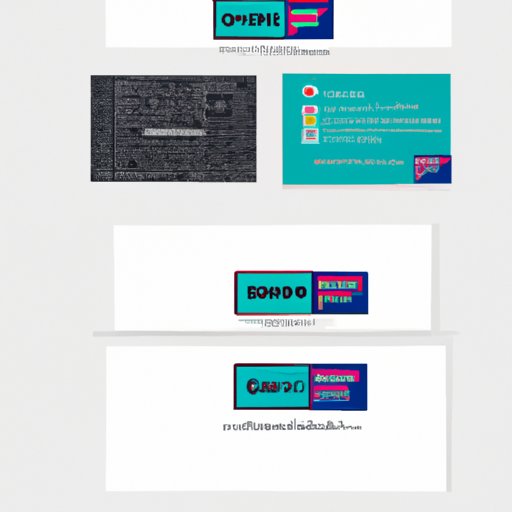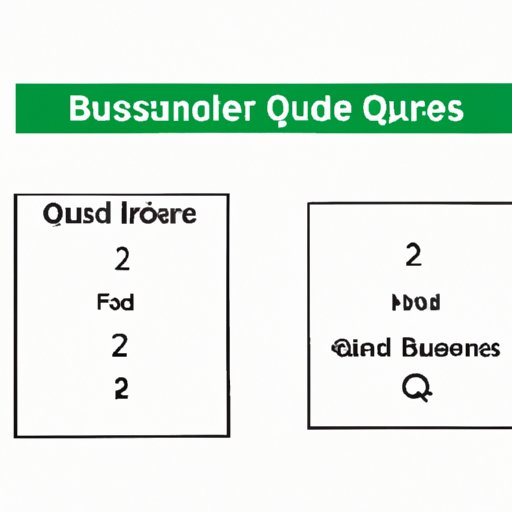
Introduction
When it comes to creating a business card, many people focus on the design and content as the most important aspects. However, one crucial factor that’s often overlooked is the size of the card. Choosing the wrong size can lead to design and print issues, as well as send an incorrect message to potential clients and customers. In this article, we’ll explore everything you need to know about business card size, as well as provide tips for selecting the right size for your needs.
Everything You Need to Know About Business Card Size
Business card size refers to the standard dimensions of a card, which can vary depending on different factors such as geographical location and custom designs. In general, business cards are rectangular or square in shape, and they typically measure around 3.5 by 2 inches.
Some businesses, however, may opt for unconventional sizes to stand out from the competition. But before you choose an unconventional size, it’s important to consider the potential drawbacks of not using standard business card dimensions.

A Quick Guide to Business Card Dimensions
The most common business card sizes include:
- Standard: 3.5 by 2 inches
- European: 3.346 by 2.165 inches
- Oceania: 3.54 by 2.165 inches
- Square: 2.5 by 2.5 inches or 2 by 2 inches
- Moo size: 3.3 by 2.16 inches
- Folding: 3.5 by 4 inches when open
It’s important to note that there may be slight variations in size depending on the printing company and the materials used for the card.
Why the Size of Your Business Card Matters
The size of your business card can impact the overall design and message you’re trying to convey. A larger card may suggest that you’re a bigger and more established business, while a smaller card may seem more minimalist and modern.
The size of your business card can also affect the perception of your brand’s quality and professionalism. A card that’s too small may be seen as cheap or low-quality, while a larger card may give the impression of higher quality and attention to detail.
Consistency is key when it comes to branding, and the size of your business card should align with other marketing materials, such as letterhead and envelopes. Maintaining consistency in your branding materials will help to reinforce your brand identity in the minds of customers and clients.
Choosing the Right Business Card Size for Your Needs
When selecting a business card size, there are several factors to consider, such as:
- The nature of your business
- The industry you’re in
- Your target audience
- Your branding goals
For example, if you’re in a creative industry, such as graphic design or photography, an unconventional size may help you stand out from the competition. However, if you’re in a more traditional industry, such as law or finance, it may be best to stick with a standard size to uphold a more professional image.
While non-standard sizes can be memorable and unique, they may also present challenges when it comes to printing and storage. Unconventional sizes may not fit into traditional business card holders, wallets, or folders that people use to keep their cards organized.
How to Stand Out with Unconventional Business Card Sizes
If you do decide to go with a non-standard size, it’s important to choose one that’s still functional and visually appealing. Some examples of creative sizes include:
- Circular or oval-shaped
- Tear-away cards
- Mini cards
- Folding or pop-up cards
When choosing an unconventional size, consider the message you want to convey and the type of audience you’re targeting. It may be helpful to consult with a professional designer to ensure that your unique size still meets industry standards and best practices for printing and design.
Commonly Used Business Card Sizes and Their Benefits
Here’s a breakdown of the most popular business card sizes:
- Standard (3.5 by 2 inches): The most widely recognized size, easy to fit into cardholders and wallets, works well for a variety of industries.
- Square (2.5 by 2.5 inches or 2 by 2 inches): A modern and unique alternative to the standard size, best for bold and creative designs.
- Folding (3.5 by 4 inches when open): Provides more space for information and design, but can be difficult to store.
When selecting a size, it’s important to consider your specific needs and how each size will affect your brand and image.
The Importance of Properly Formatting Your Business Card Design for Your Chosen Size
Once you’ve chosen the right size for your business card, it’s important to design and format it correctly to ensure optimal impact. Considerations to keep in mind include:
- Bleed size: The area that extends beyond the actual dimensions of the card, which allows for trimming and finishing.
- Safe zone: The area within the card where important information and design elements should be placed to avoid getting cut off.
- Resolution: Ensure that images and text are high-resolution to avoid blurry or pixelated imagery.
Working with a professional designer or printing company can help ensure that your business card is properly formatted and optimized for printing.
Conclusion
Choosing the right size for your business card is a crucial step in creating a successful marketing tool. By considering industry standards, your branding goals, and your target audience, you can select a size that will help convey the right message and make a lasting impression. Remember, maintaining consistency in your branding materials and formatting your design correctly are key to creating a cohesive and effective marketing campaign.
Don’t overlook the importance of business card size as you create your marketing materials. By choosing the right size and designing it correctly, you can create a professional and memorable image for your brand.




